#rhino horn
Text

Pedro Jarque Krebs - Priceless
$60,000 USD a kilo, that's what a rhino horn costs on the black market. More expensive than gold. But life is priceless. Unlike elephant tusks, which are made of ivory, rhino horns are made of keratin, the same material as nails. But the ignorance and superstition of some humans give it non-existent medicinal properties. As in everything, as long as there are buyers, there will be sellers. This will only end in education.
50 notes
·
View notes
Text
Regarding the mention of Blackbeard taking a lot of rhino horn, it may be an aphrodisiac innuendo or something else but aphrodisiac use of poached rhino horn is rare, in Vietnam the most widespread medicinal use (that I'm sure does nothing) is in/as a hangover remedy, and some consumption is just (I gather) pointless ostentation
#ofmd s2 spoilers#ofmd s2#ofmd season 2#edward teach#rhino horn#that izzy teaser#archie#our flag means death#ofmd s2 speculation#it'd be like taking crushed toenails actually#um#yuck
18 notes
·
View notes
Text
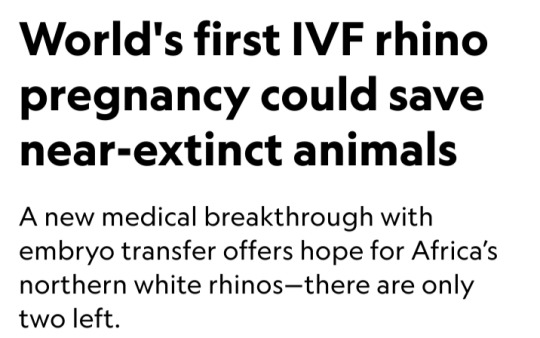

By Dina Fine Maron
January 24, 2024
Scientists have cleared a significant hurdle in the years-long effort to save Africa’s northern white rhinoceros from extinction with the first-ever rhino pregnancy using in vitro fertilization.
The lab-assisted pregnancy, which researchers will announce today, involved implanting a southern white rhino embryo in a surrogate mother named Curra.
The advance provides the essential “proof of concept” that this strategy could help other rhinos, says Jan Stejskal of the BioRescue project, the international group of scientists leading this research.
Curra died just a couple months into her 16-month pregnancy from an unrelated bacterial infection, Stejskal says.
However, the successful embryo transfer and early stages of pregnancy pave the way for next applying the technique to the critically endangered northern white rhino.
The process was documented exclusively by National Geographic for an upcoming Explorer special currently slated to air in 2025 on Nat Geo and Disney+.
BioRescue expects to soon implant a northern white rhino embryo into a southern white rhino surrogate mother.
The two subspecies are similar enough, according to the researchers, that the embryo will be likely to develop.
Eventually, this approach may also help other critically endangered rhinos, including the Asian Javan rhinoceros and the Sumatran rhinoceros, which each now number under 100 individuals, Stejskal says.
But the northern white rhino’s current situation is the most pressing by far.
There are no males left, and the only two remaining animals are both elderly females that live under armed guard on a reserve in a 700-acre enclosure in Kenya called Ol Pejeta Conservancy.
The boxy-jawed animals once roamed across central Africa, but in recent decades, their numbers have plummeted due to the overwhelming international demand for their horn, a substance used for unproved medicinal applications and carvings.
Made from the same substance as fingernails, rhino horn is in demand from all species, yet the northern white rhino has been particularly hard-hit.
"These rhinos look prehistoric, and they had survived for millions of years, but they couldn’t survive us,” says Ami Vitale, a National Geographic Explorer and photographer who has been documenting scientists’ efforts to help the animals since 2009.
“If there is some hope of recovery within the northern white rhino gene pool — even though it’s a substantially smaller sample of what there was — we haven’t lost them,” says conservation ecologist David Balfour, who chairs the International Union for the Conservation of Nature’s African rhino specialist group.
Blueprints for rhino babies
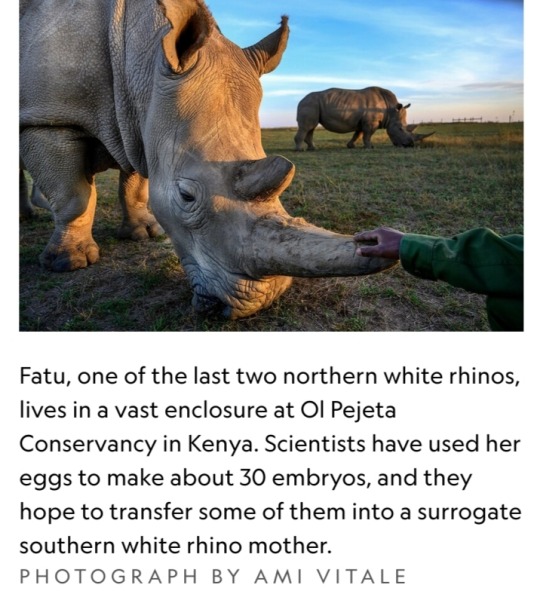
To stave off the animal’s disappearance, BioRescue has used preserved sperm from northern white rhinos and eggs removed from the younger of the two remaining females.
So far, they’ve created about 30 preserved embryos, says Thomas Hildebrandt, the head scientist of BioRescue and an expert in wildlife reproduction based at the Leibniz-Institute of Zoo and Wildlife Research in Berlin.
Eventually, the team plans to reintroduce northern white rhinos into the wild within their range countries.
“That’d be fantastic, but really, really far from now—decades from now,” says Stejskal.
Worldwide, there are five species of rhinoceros, and many are in trouble.
Across all of Africa, there are now only about 23,000 of the animals, and almost 17,000 of them are southern whites.
Then there are more than 6,000 black rhinos, which are slightly smaller animals whose three subspecies are critically endangered.
In Asia, beyond the critically endangered Javan and Sumatran rhinos, there’s also the greater one-horned rhino, whose numbers are increasing and currently are estimated to be around 2,000.
The BioRescue effort has experienced many setbacks, and even though the team now has frozen embryos, the clock is ticking.
The researchers intend to use southern white rhinos as surrogate moms for the northern white rhino embryos.
However, scientists want any northern white rhino calves to meet and learn from others of their kind, which means they need to be born before the two remaining females die.
“These animals learn behaviors — they don’t have them genetically hard-wired,” says Balfour, who’s not involved with the BioRescue work.
But birthing new animals in time will be a challenge.
“We’re really skating on the edge of what’s possible,” he says, “but it’s worth trying.”
Najin, the older female, will be 35 this year, and Fatu will be 24.
The animals, which were born in a zoo in the Czech Republic, are expected to live to about 40, says Stejskal, who also serves as director of international projects at the Safari Park Dvůr Králové, the zoo where the animals lived until they were brought to Kenya in 2009.
Impregnating a rhino
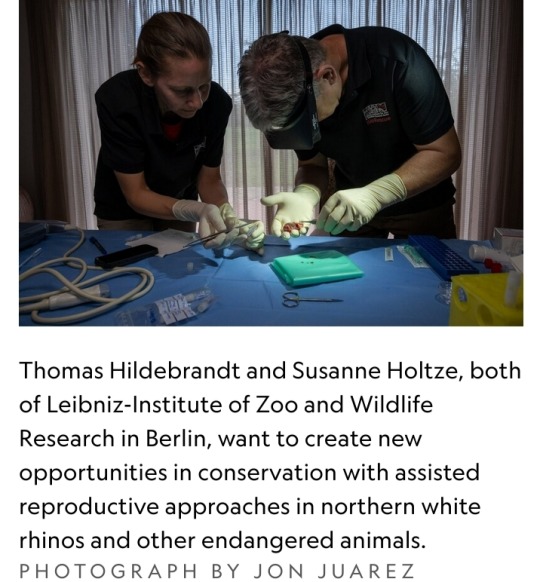
The next phase of BioRescue’s plan involves implanting one of their limited number of northern white rhino embryos into a southern white rhino surrogate mother — which the group plans to do within the next six months, Stejskal says.
They’ve identified the next surrogate mother and set up precautions to protect her from bacterial infections, including a new enclosure and protocols about disinfecting workers’ boots.
But now, they must wait until the female rhino is in estrus — the period when the animal is ready to mate — to implant the egg.
To identify that prime fertile time, they can’t readily perform regular ultrasounds at the conservancy as they might do in a zoo.
Instead, they have enlisted a rhino bull that has been sterilized to act as a “teaser” for the female, Hildebrandt says, adding that they must wait a few months to make sure that their recently sterilized male is truly free of residual sperm.
Once the animals are brought together, their couplings will alert conservancy staff that the timing is right for reproductive success.
The sex act is also important because it sets off an essential chain of events in the female’s body that boosts the chances of success when they surgically implant the embryo about a week later.
"There’s little chance the conservancy staff will miss the act. White rhinos typically mate for 90 minutes," Hildebrandt says.
What’s more, while mounted on the females, the males often use their temporary height to reach tasty plant snacks that are generally out of reach.
Boosting genetic diversity
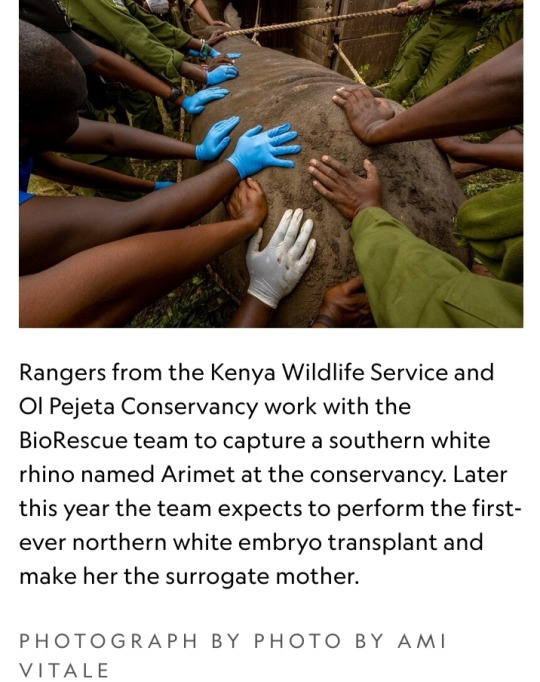
With so few northern white rhinos left, their genetic viability may seem uncertain.
But the BioRescue team points to southern white rhinos, whose numbers likely dropped to less than 100, and perhaps even as few as 20, due to hunting in the late 1800s.
Government protections and intense conservation strategies allowed them to bounce back, and now there are almost 17,000.
“They have sufficient diversity to cope with a wide range of conditions,” says Balfour.
Researchers don’t know exactly how many southern white rhinos existed a century ago, he says, but it’s clear that the animals came back from an incredibly low population count and that they now appear healthy.
Beyond their small collection of embryos, the BioRescue team hopes to expand the northern white rhino’s gene pool by drawing from an unconventional source — skin cells extracted from preserved tissue samples that are currently stored at zoos.
They aim to use stem cell techniques to reengineer those cells and develop them into sex cells, building off similar work in lab mice.
According to their plan, those lab-engineered sex cells would then be combined with natural sperm and eggs to make embryos, and from there, the embryos would be implanted into southern white rhino surrogate mothers.
Such stem cell reprogramming work has previously led to healthy offspring in lab mice, Hildebrandt says, but rhinos aren’t as well-studied and understood as mice, making this work significantly challenging.
A global effort
The northern white rhino revitalization venture has cost millions of dollars, supported by a range of public and private donors, including the German Federal Ministry of Education and Research.
Other partners on the effort include the Leibniz Institute for Zoo and Wildlife Research, the Czech Republic’s Safari Park, Kenya Wildlife Service, Ol Pejeta Conservancy, and also Katsuhiko Hayashi, a professor of genome biology at Osaka University in Japan who conducted the mouse stem cell research.
Building upon Hayashi’s stem cell techniques could ultimately bring the northern white rhino gene pool up to 12 animals — including eggs from eight females and the semen of four bulls, according to Stejskal.
An alternative approach to making more babies, like crossbreeding northern and southern white rhinos, would mean the resulting calves wouldn’t be genetically pure northern white rhinos, Hildebrandt notes.
The two subspecies look quite similar, but the northern version has subtle physical differences, including hairier ears and feet that are better suited to its swampy habitat.
The two animals also have different genes that may provide disease resiliency or other benefits, Hildebrandt says.
There are unknown potential differences in behavior and ecological impact when populating the area with southern white rhinos or cross-bred animals.
"The northern white rhino is on the brink of extinction really only due to human greed,” Stejskal says.
“We are in a situation where saving them is at our fingertips, so I think we have a responsibility to try.”
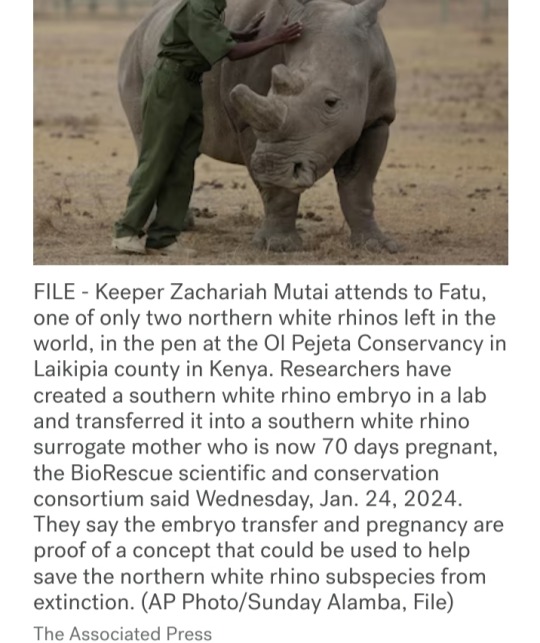
🩶🦏🩶
#northern white rhinoceros#rhino embryo transfer#in vitro fertilization#IVF#southern white rhinoceros#critically endangered animals#National Geographic#BioRescue#rhino horn#International Union for the Conservation of Nature#African rhino specialist group#Thomas Hildebrandt#German Federal Ministry of Education and Research#Leibniz Institute for Zoo and Wildlife Research#Kenya Wildlife Service#Ol Pejeta Conservancy#Katsuhiko Hayashi#genome biology#IVF rhino pregnancy
8 notes
·
View notes
Text
I was thinking about how rhino horns are basically just keratin, the same as fingernails. So Ed and Hornigold get "high" on ground fingernails, that is, not at all.
In my head, they are victims of the placebo effect. Someone once told them that rhino horn would give them a great high, and they just went with it.

9 notes
·
View notes
Text
SEASON 2 SPOILERS
Did some research on rhino horn cause I was curious.
According to Google the drug came on the scene in 2012 (but had existed long before that) and “is made up of keratin.”
Rhino Horn connects to China, according to two sources:
“According to traditional Chinese texts, such as Li Shih-chen's 1597 medical text “Pen Ts' ao Kang Mu”, rhino horn has been used in Chinese medicine for more than 2,000 years and is used to treat fever, rheumatism, gout, and other disorders.”
”For centuries, rhino horn has been used in traditional Chinese medicine (TCM) to treat a wide variety of illnesses”
And Vietnam:
“The belief in Vietnam is that drinking a tonic made from the horn will detoxify the body after a night of heavy boozing, and prevent a hangover” so “users aren’t getting high”
—————-
Soooooo maybe Ed has been having nights of crying and drinking and the rhino horn refreshes him? Idk it seems like it makes him unhinged actually, like Hornigold. It does have “adverse effects.” Or it could probably be DJ putting his own spin on it.
So like what made DJ chose that? I assume because of the Chinese influence he is weaving through season 2. Tbh I’d do so just because of the name. Totally fits.
Part of the reason I researched rhino horn was to see if it caused withdrawals? I couldn’t find anything on a surface level google search. It doesn’t seem like it is quite a drug drug like I was thinking
But either way…did Ed go through withdrawal that quickly? It was just one night? I doubt it…but if rhino horn is that type of drug in this word…I kinda hope we see him going through withdrawal and recovery as a part of his healing because who knows how long he was using.
Also also, apparently there is a myth that it was considered an aphrodisiac.
Annnnnnd apparently rhino horn is considered a “status drug” and I’m not even going to go into how they get the substance cause I’ll make myself cry. But the implication fits with the toxicity of Ed in the first 3 episodes.
Feel free to share your thoughts! I would love to know y’all’s speculation. And if I’m wrong or mistaken, correct me!
#spoilers#our flag means death#ofmd#ofmd s2 spoilers#blackbeard#edward teach#rhino horn#tw drugs#s2#our flag means death season 2#OFMD s2#OFMD season 2#ofmd season 2 speculation#ofmd season 2 spoilers#according to Google#tw animal abuse#drugs#drug misuse#I’m putting all the tags so it gets filtered correctly#season 2 meta#OFMD meta#our flag means death meta#tw substance abuse
10 notes
·
View notes
Text

Rhinos: Killing & Corruption (FULL DOCUMENTARY) | BBC News
Alastair Leithead investigates the alleged links b/w the illegal rhino horn trade & corruption in Zululand's courts & its national parks.
Rhinos: Killing & Corruption | Fraud Story Telling
Official Site
0 notes
Text
#ofmd#our flag means death#rhino horn#this is insane#ofmd s2 spoilers#edward teach#ofmd s2#taika waititi#blackbeard#mutha fukin Blackbeard#spoilers#ofmd season 2 spoilers
1 note
·
View note
Text

World Rhino Day 2023 世界犀牛日
HEY HUMAN, SEE WHAT YOU DO!?
ANIMAN - HORNLESS RHINO 無角犀
Instagram: milkdongcomics
Facebook: Milk DoNg Comics
#World Rhino Day#世界犀牛日#Rhino#犀牛#Rhino Horn#犀牛角#Rhino Poaching#ANIMAN#HEY HUMAN SEE WHAT YOU DO!?#Milk DoNg#Milk DoNg Comics#Art#Drawing#Sketching#Painting#Illustration#Character Design#Color Pencil
0 notes
Text
How would a rhino wear a hat?
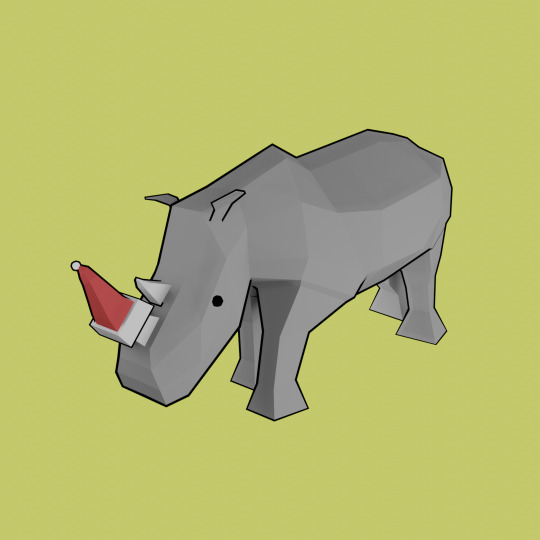
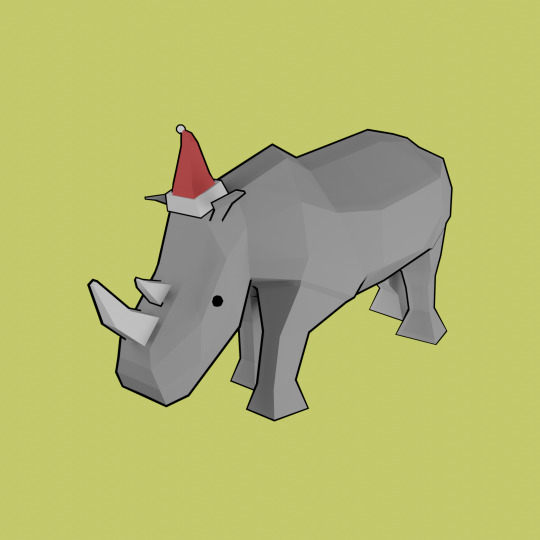
Rhino Christmas!
#piki's silly little guys#blender#3d#low poly#rhinoceros#i thought that putting a christmas hat on a rhinos horn was an original idea#turns out its not *sigh*
418 notes
·
View notes
Text
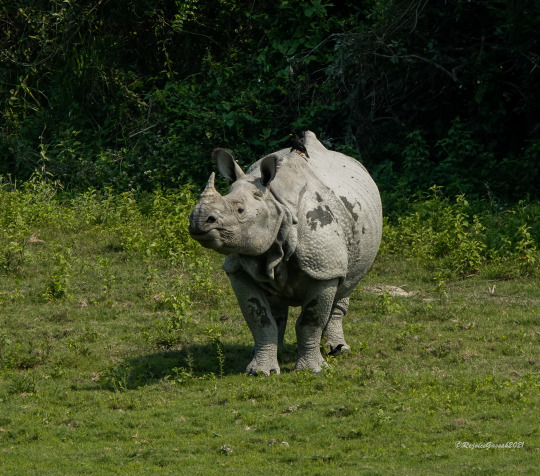
Meet the greater one-horned rhino (Rhinoceros unicornis). This mighty mammal can weigh as much as 6,000 lbs (2,721 kg)! It’s distinguished by its single horn, which can reach lengths of 25 in (63 cm). Despite its size, this herbivore can move quickly, charging at speeds of up to 25 mph (40 km/h). This semi-aquatic animal prefers to live near water and tends to inhabit swamps, riversides, and forests in parts of Asia, including Nepal and India.
Photo: rejoicegassah, CC BY 4.0, iNaturalist
#nature#animals#rhino#did you know#fact of the day#greater one horned rhino#cool animals#animal kingdom#mammals
475 notes
·
View notes
Text
you know how marco polo saw an indian rhino in sumatra and, instead of thinking, "perhaps this is completely different creature than the one I am thinking of," he just went "oh man, we really got our depictions of unicorns wrong" ? monsignor pruitt and the horrifying murderous blood drinking "angel" in the cave.
#midnight mass#also that passage about him seeing a 'unicorn' and going#my god they're ugly as shit#is like. my favorite thing.#marco polo was like well it's got one horn sooooo#pruitt was like well it does weird shit and it's got wings soooooo#also before anyone points it out#unlike other types of rhino the indian rhino only has one horn
868 notes
·
View notes
Text

Welcome Whitney the Rhinoceros Beetle to the Pretty Bug Club!!
2023
digital art
Available as stickers and totes on my redbubble!
Piece time lapse!
#xlemonprince#art#digital art#my art#pretty bug club#bug art#tw bug#bug#rhino beetle#rhinoceros beetle#insect art#horned beetle#artist on tumblr#art on tumblr#small artist#art timelapse
186 notes
·
View notes
Text
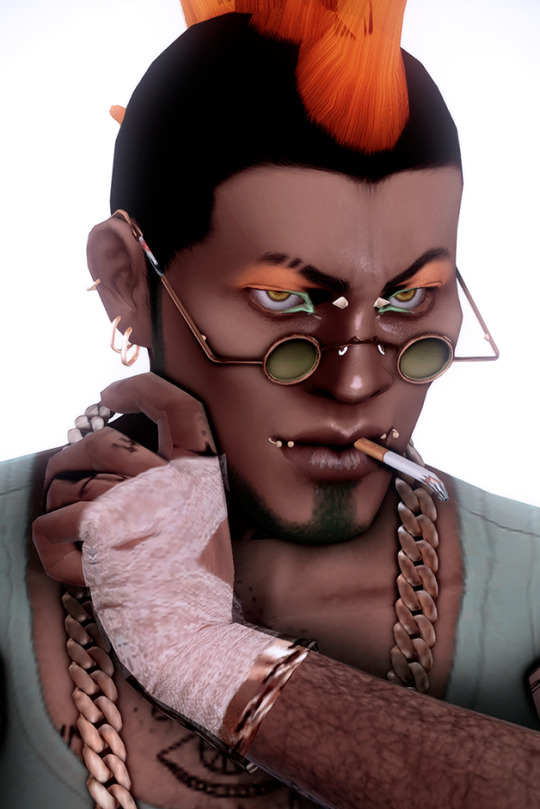


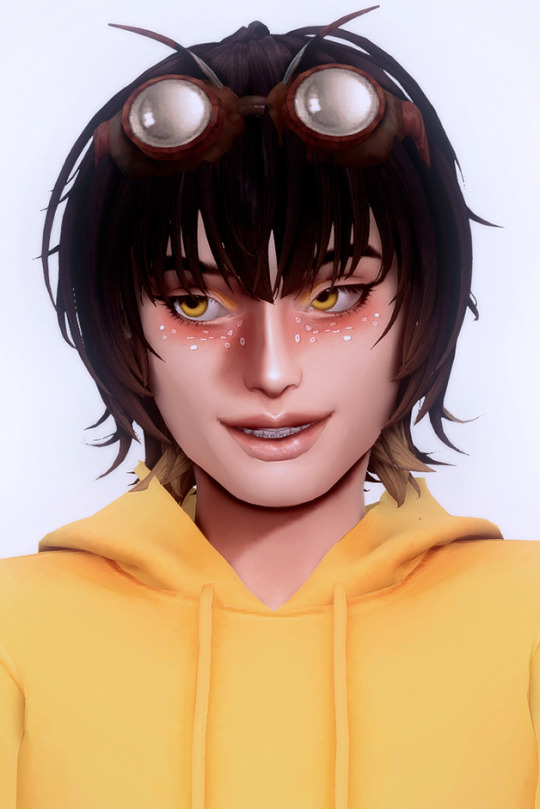
Team Chaotix
#ts4#sonic heroes#vector the crocodile#espio the chameleon#charmy bee#team chaotix#back on my sonic shit#can you tell I like my guys pierced#I searched high and low for a rhino piercing for Espio but came out empty handed#I really wanted to replicate the lil' horn he has :(#also I should start to post full body screens because their fits look nice ;;
172 notes
·
View notes
Note
SORRY OKAY SO you made a tweet about how you thought itd be painful for unicorns to nurse bc of the horn and immediately my brain went "." like. there what if there was just a bump there right? hear me out. baby bumb pforehead... is the base of the horn but since im assuming the horns would be made of like keratin wouldnt it just grow with time?? so like... infant unicorns just have this like. mump. and it gets sharp cause they do some haxorus shit or something. im very tired

Yeagh... Unicorns having little horn buds my beloved
#mailbox#i mean realistically. ig rhinos have this issue solved but i like unicorns being a bovine species anyway#<-also potentially intresting implications to baby unicorns being designed to mimic regular horses#until their horns start growing
239 notes
·
View notes
Text

I turned some beetles I painted in watercolor into a riso print 🪲
#bugs#my art#risograph#illustration#illustrator#riso#risograph print#riso print#beetle#beetles#clown beetle#goliath beetle#ground beetle#rhino beetle#horned dynastid#jewel beetle#lady bug#leaf beetle#ox beetle#hercules beetle#scarab beetle#stag beetle#art nouveau#art nouveau print
628 notes
·
View notes
Text
It's been several months but I can't stop thinking about when I reblogged a post that talked about how you shouldn't buy nautilus or abalone shells because these animals are very much endangered or threatened by extinction in part due to the overharvesting of their shells, and then someone reblogged it from me with the tag "abalone shells fuck majorly i got one on my shelf"
????? I'm sorry but read the room??????
#yes of course they already had the shell! them deciding not to say this wouldnt have brought the abalone back#but... a post saying that abalone shells are bad because several species are nearly extinct and going “oh i love abalone shells” is.. hmm??#me going to the anti-poaching convention to talk about how much i love my rhino horns and tiger hide carpet#me going to the anti-fur industry protest to tell others how my mink coat is so great#anyway now that ive said it i can finally leave this thing to rest
107 notes
·
View notes